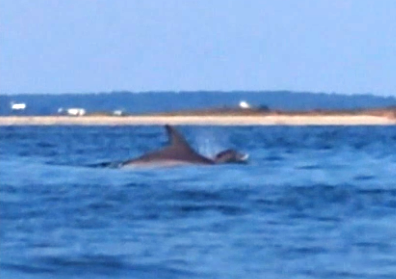Jimmy and I were up early. We drove to
Veterans Memorial Park which was an easy walk from the house but a long way to carry the boats. We then launched at the ramp.
The two of us rode the outgoing tide into the
Chincoteague Inlet. We eventually landed on the southwest side of
Toms Cove Hook, just south of
Fishing Point on
Assateague Island.
Normally, one cannot land there between March 15 and August 31 because it is a nesting area for birds. But now that it was September, we were free to go ashore so that is what we did. In the past, I've found several large shells there. I was hoping to do the same today. We found a few pretty quickly but it didn't take long to realize that most of the beach was bare. I figured it was near low tide so maybe we could look just below the waterline and find things that other shell hunters might have missed when the water was higher. But even below the low water mark, there wasn't much to be seen.
I noticed that there were spots here and there under water where algae was growing out of the sand. I wondered why it was growing just in these (apparently random) places. So I stuck my hand in the sand and dug down. It didn't take long before I pulled up a big shell. I tried it again and found another big shell. I told Jimmy about this and he also started digging. We did this for about 45 minutes, gathering dozens of large shells. Jimmy and I had so many that we could be picky so we took only the best.
I decided that the smart thing was to load them in my
Prijon Catalina, which I was paddling. The reason for this is that unlike the
Cobra Expedition, which he paddled, I carry the Prijon upright on my car. This means we could use the Prijon to get the shells back to the car and not have to flip it over and possibly damage the shells. I certainly didn't mind carrying the extra weight.
I loaded my shells in the rear compartment while Jimmy put his in the front. My boat was packed to the gills.
Back in the water, we started heading back. Here's Jimmy.
Shortly after rounding Fishing Point, we saw a couple of dolphin in the distance. We paddled towards them. Unfortunately, they were not in big schools like when Norma, Carmen, and I saw them on
July 17, 2011. We tried to take photos and videos of the dolphin but they were too elusive and they seemed to be able to hold their breath forever. Over the next hour, we saw about ten. Not a lot, but certainly enough to quench my craving for seeing some marine mammals. Things were quiet enough so that if they weren't too far away, we could hear them expel air as they broke the surface. Click the below image to start a video.
The return trip took much longer since the tide was not as cooperative. But at least boat traffic wasn't bad and the water conditions were fairly calm.
We made it back a little after noon, having paddled about 9.5 miles.
Back at the house, we unpacked our shells. You can see Jimmy's shells in the below picture. The one in the top right position is a lightning whelk. The one in the second row, and third from the left is a channeled whelk. All the others are knobbed whelk.
Our count of big shells is as follows:
Knobbed whelk: 60 total: 28 for Jimmy and 32 for me. This is the New Jersey and Georgia state shell.
Lightning whelk: Seven total; one for Jimmy and six for me. This is the Texas state shell. It was unusual finding these because normally, they are not found north of North Carolina.
Channeled whelk: Two total; one for Jimmy and one for me.
You can identify the channeled whelk by their smooth spire.
1 / 2

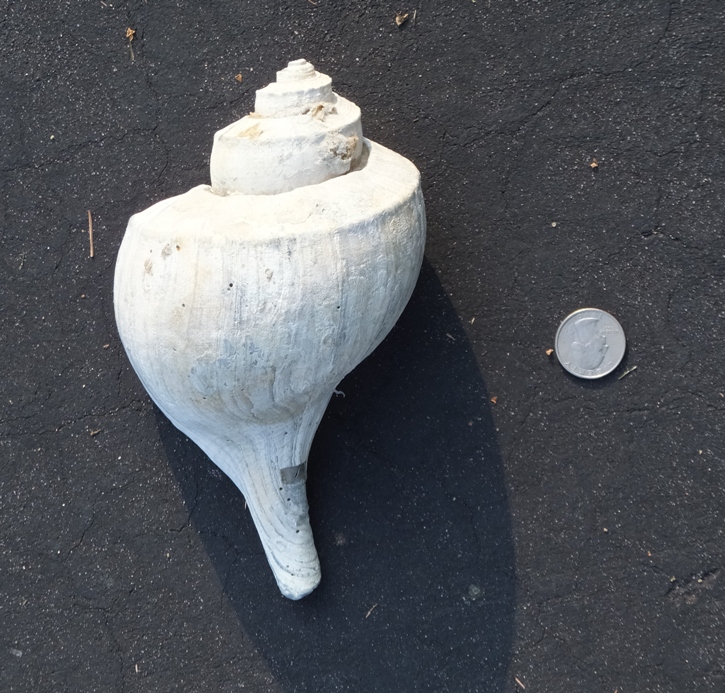
Opening facing away.
2 / 2

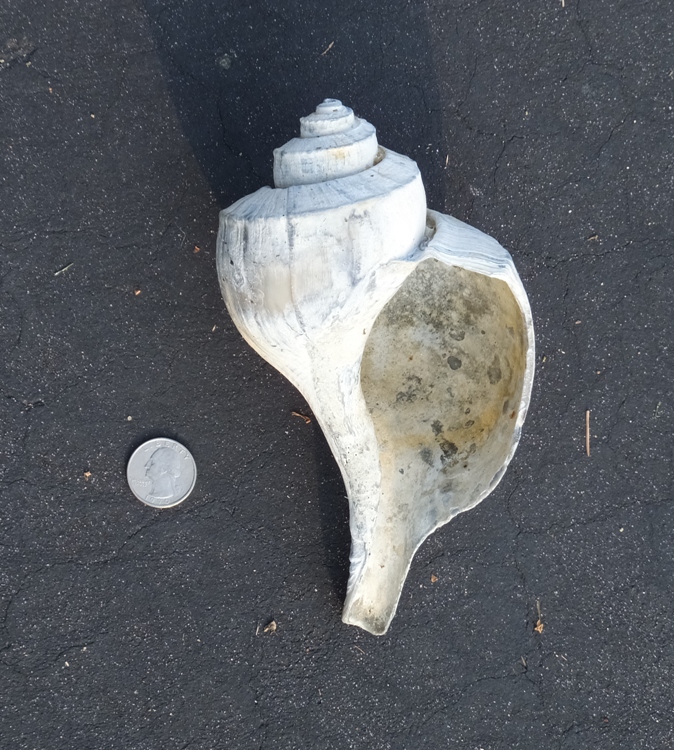
Opening facing.
❮
❯
It took me awhile to be able to distinguish the knobbed from the lightning whelk. Dr. Paul F. of the
Smithsonian Environmental Research Center (SERC) helped me with that. The knobbed whelk are almost always right handed which means if the spiral is faced upward, it fits in your right hand. In contrast the lightning whelk are almost always left handed. How do you distinguish the rare exceptions of a left handed knobbed whelk or a right handed lightning whelk? Just look at the spire. The lightning whelk has a much lower spire. I checked and that was certainly the case for all mine. Thanks Dr. Paul!
In the below pics, the lightning whelk is on the left while the knobbed whelk is on the right.
1 / 3

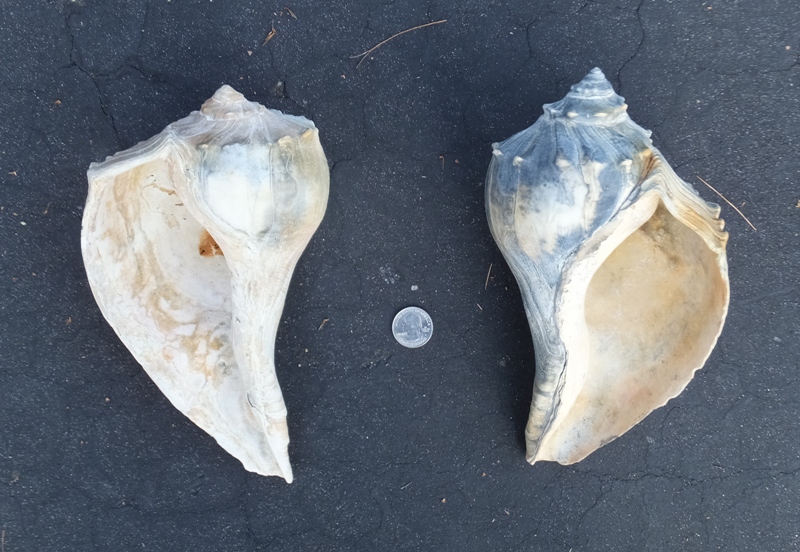
Lightning whelks tended to be bigger.
2 / 3

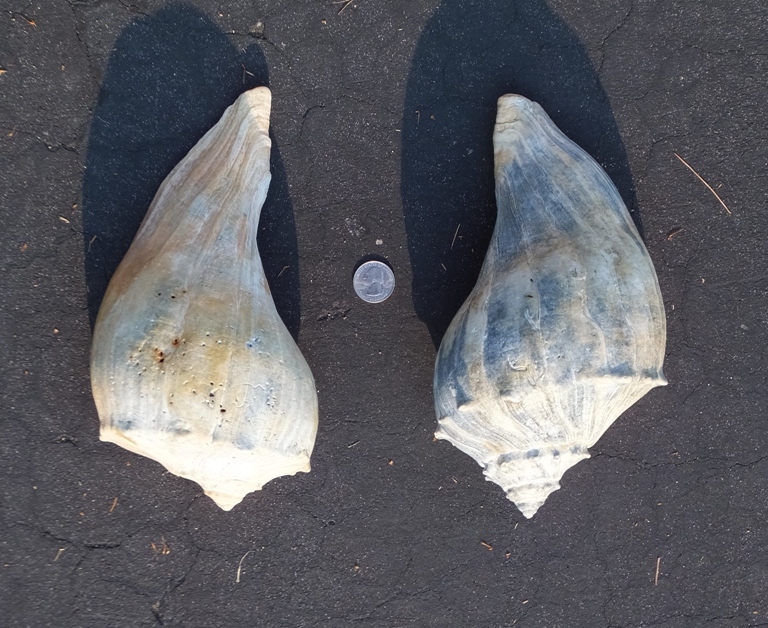
Another view.
3 / 3

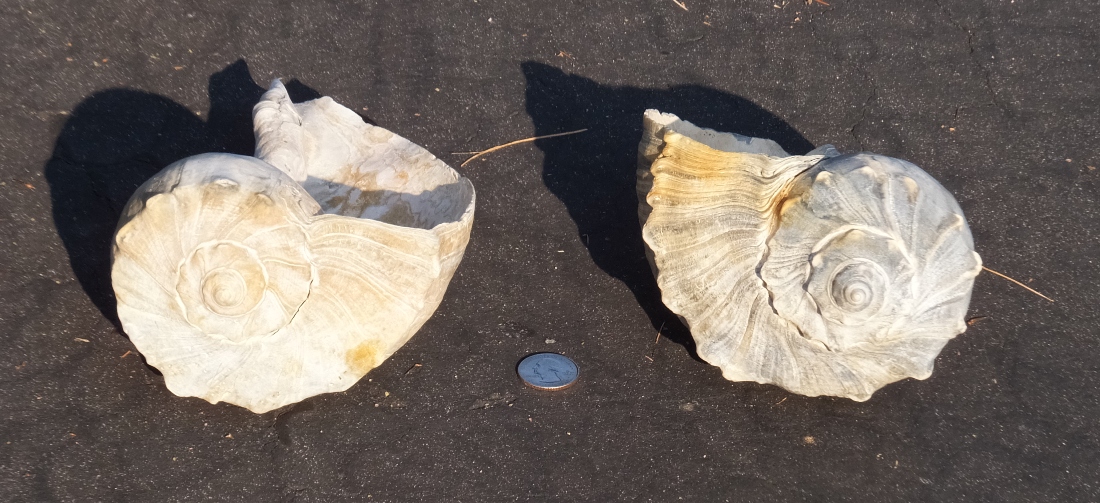
Top view.
❮
❯
Both the Knobbed Whelk and Lightning Whelk are extremely variable species. The shells of each individual species differ considerably in shape, spire height, siphonal canal length, coloration, weight, size and number of knobs/spines, etc. Fortunately, species identification 99.9% of the time is assured owing to the fact that the Knobbed Whelk is dextral (right handed - opening to the right when held with the spire up) while the Lightning Whelk is sinistral (left handed - opening to the left when held with the spire up). However, both species on rare occasions are known to produce reverse coiled specimens (a shell eagerly sought by collectors and both known from northeast Florida) which can complicate easy identification in some instances.
- from
Jacksonville Shell Club - Guide to Northeast Florida Whelks
This species [the lightning whelk] shares many characteristics with another species, the knobbed whelk (Busycon carica), but there are some important differences:
Lightning whelks are sinistral in coiling, whereas knobbed whelks are dextral.
Lightning whelks have a lower spire than the knobbed whelk.
The knobs of the lightning whelk are usually less well-developed than those of the knobbed whelk.
Lightning whelks prefer to stay in deeper waters than the knobbed whelks when feeding on mud flats [so they would be harder to find for the recreational shell hunter].
- from
Wikipedia - Lightning Whelk
Based on the above, a right handed knobbed whelk occurs with probability 0.999 while a left handed one has a probability of 0.001. So what is the probability of finding seven more left handed knobbed whelk out of a random sample of 67? According to my calculation, the answer is
8.198 * 10^-13. This is an incredibly small number. How small? The chance of winning the jackpot in the Mega Millions multi-state lottery is 4,712 times as great. So it is pretty safe to say that the southpaw whelk that I found were lightning whelk and
not knobbed whelk.
I have since given many of these shells to friends and donated the
best ones to the
Robinson Nature Center. I've acquired a few too many things of the natural world from all my kayaking and paddleboarding. It is getting hard to keep track of them all and I figured others can make better use of them than me.


